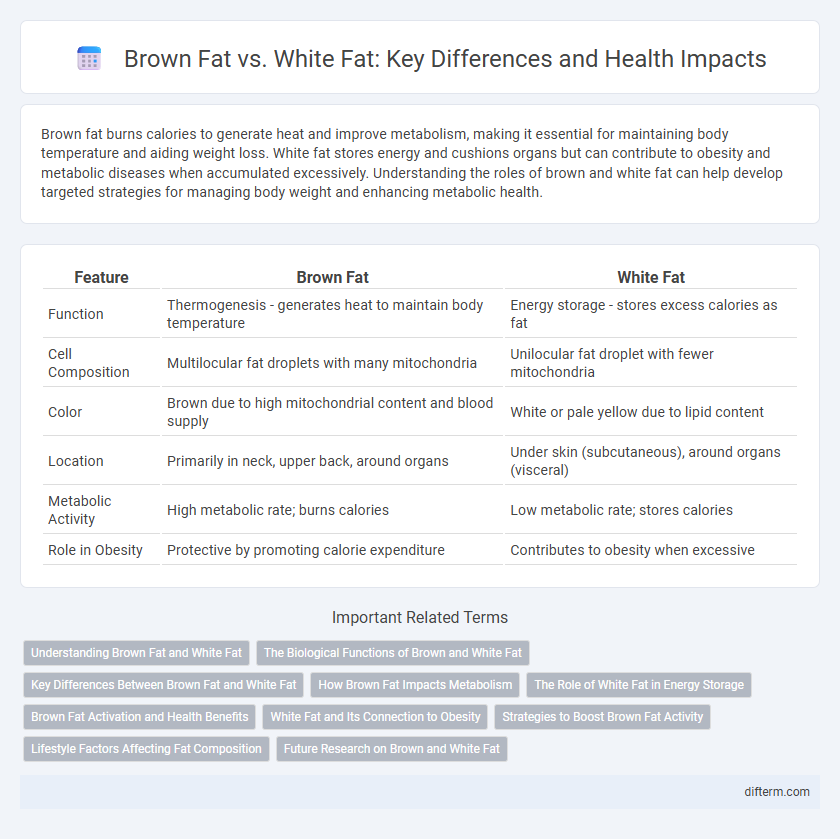Brown fat burns calories to generate heat and improve metabolism, making it essential for maintaining body temperature and aiding weight loss. White fat stores energy and cushions organs but can contribute to obesity and metabolic diseases when accumulated excessively. Understanding the roles of brown and white fat can help develop targeted strategies for managing body weight and enhancing metabolic health.
Table of Comparison
| Feature | Brown Fat | White Fat |
|---|---|---|
| Function | Thermogenesis - generates heat to maintain body temperature | Energy storage - stores excess calories as fat |
| Cell Composition | Multilocular fat droplets with many mitochondria | Unilocular fat droplet with fewer mitochondria |
| Color | Brown due to high mitochondrial content and blood supply | White or pale yellow due to lipid content |
| Location | Primarily in neck, upper back, around organs | Under skin (subcutaneous), around organs (visceral) |
| Metabolic Activity | High metabolic rate; burns calories | Low metabolic rate; stores calories |
| Role in Obesity | Protective by promoting calorie expenditure | Contributes to obesity when excessive |
Understanding Brown Fat and White Fat
Brown fat and white fat serve distinct functions in the human body; brown fat primarily generates heat through thermogenesis and helps regulate body temperature, while white fat stores excess energy as triglycerides and cushions organs. Brown fat contains a high density of mitochondria rich in iron, giving it its characteristic color and enabling its energy-burning capacity. Understanding the metabolic roles of brown fat compared to white fat is crucial for developing therapeutic strategies targeting obesity and metabolic disorders.
The Biological Functions of Brown and White Fat
Brown fat specializes in thermogenesis by generating heat through the activation of mitochondria, playing a critical role in maintaining body temperature and energy balance. White fat primarily functions as an energy reservoir, storing excess calories as triglycerides and releasing fatty acids during periods of energy deficit. These distinct biological functions of brown and white fat contribute to metabolic health, with brown fat enhancing energy expenditure and white fat regulating energy storage.
Key Differences Between Brown Fat and White Fat
Brown fat contains numerous mitochondria that generate heat through non-shivering thermogenesis, aiding in calorie burning and temperature regulation. White fat primarily stores energy as large lipid droplets and contributes to insulation and cushioning of internal organs. Unlike white fat, brown fat is metabolically active and helps improve glucose metabolism, which can influence obesity and metabolic health.
How Brown Fat Impacts Metabolism
Brown fat contains a high number of mitochondria that burn calories to generate heat, significantly boosting metabolic rate compared to white fat, which primarily stores energy. Activation of brown fat through cold exposure or certain hormones enhances thermogenesis, promoting increased energy expenditure and potential weight loss. This metabolic effect makes brown fat a key target for therapies aimed at improving insulin sensitivity and combating obesity.
The Role of White Fat in Energy Storage
White fat primarily functions as the body's energy reservoir by storing excess calories in the form of triglycerides within adipocytes. This adipose tissue also plays a crucial role in endocrine signaling, releasing hormones like leptin that regulate appetite and metabolism. Unlike brown fat, white fat has a lower mitochondrial density and minimal heat production, emphasizing its role in long-term energy storage rather than thermogenesis.
Brown Fat Activation and Health Benefits
Brown fat, rich in mitochondria, specializes in thermogenesis by burning calories to generate heat, which aids in maintaining body temperature and combating obesity. Activating brown fat through cold exposure, exercise, or certain foods like capsaicin enhances metabolic rate and improves insulin sensitivity, reducing risks of type 2 diabetes and cardiovascular diseases. Its unique ability to convert excess calories into heat rather than storing them as white fat highlights brown fat activation as a promising target for weight management and metabolic health interventions.
White Fat and Its Connection to Obesity
White fat primarily functions as energy storage, accumulating excess calories as triglycerides, which contributes significantly to obesity. This adipose tissue releases inflammatory cytokines that disrupt metabolic processes, increasing the risk of insulin resistance and cardiovascular diseases. Targeting white fat reduction through diet and exercise remains a crucial strategy in managing obesity and improving overall metabolic health.
Strategies to Boost Brown Fat Activity
Increasing exposure to cold temperatures stimulates brown fat activation by promoting thermogenesis and energy expenditure. Incorporating regular high-intensity interval training (HIIT) workouts can enhance brown fat density and its metabolic function. Consuming foods rich in capsaicin, such as chili peppers, supports brown fat activity by triggering heat production and fat oxidation.
Lifestyle Factors Affecting Fat Composition
Lifestyle factors play a crucial role in determining the composition of brown fat and white fat in the body. Regular exposure to cold temperatures and physical activity can increase the amount of brown fat, which is metabolically active and aids in burning calories. Conversely, a sedentary lifestyle and poor diet contribute to the accumulation of white fat, which primarily stores energy and is linked to obesity and metabolic diseases.
Future Research on Brown and White Fat
Future research on brown and white fat targets understanding their distinct roles in metabolism and energy regulation, aiming to develop innovative treatments for obesity and metabolic disorders. Advanced studies focus on the molecular pathways that activate brown fat thermogenesis and white fat browning, enhancing energy expenditure. Exploring genetic and environmental factors influencing fat cell plasticity could unlock novel therapeutic strategies to combat insulin resistance and cardiovascular diseases.
Brown Fat vs White Fat Infographic

 difterm.com
difterm.com